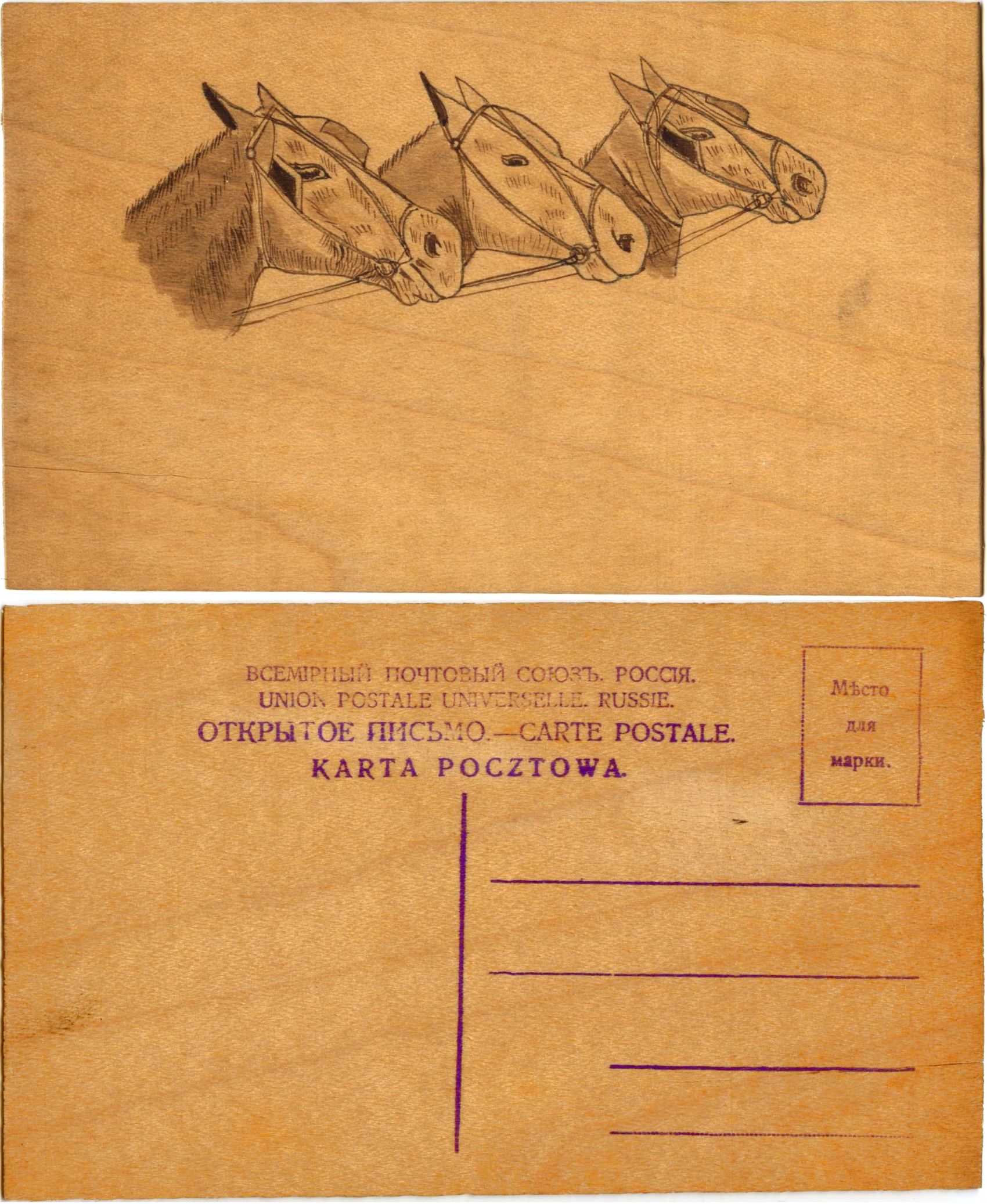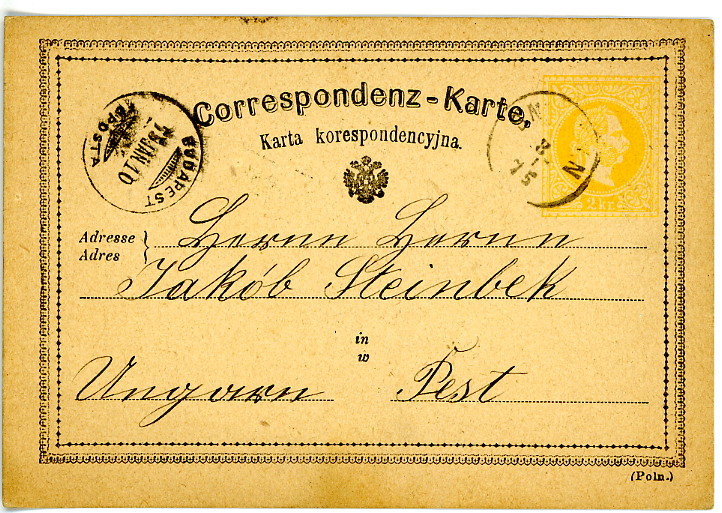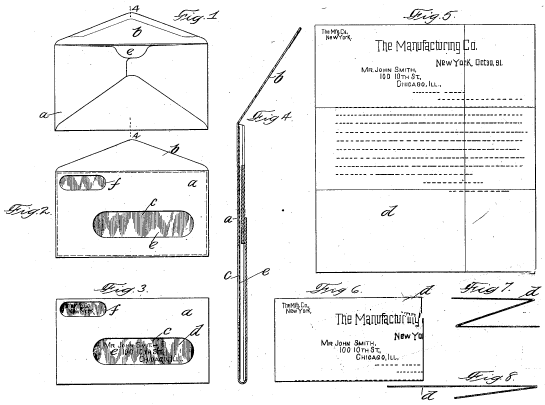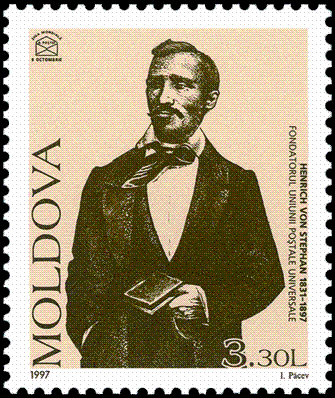|
Postcard
A postcard or post card is a piece of thick paper or thin cardboard, typically rectangular, intended for writing and mailing without an envelope. Non-rectangular shapes may also be used but are rare. There are novelty exceptions, such as wooden postcards, copper postcards sold in the Copper Country of the U.S. state of Michigan, and coconut "postcards" from tropical islands. In some places, one can send a postcard for a lower fee than a letter. Stamp collectors distinguish between postcards (which require a postage stamp) and postal cards (which have the postage pre-printed on them). While a postcard is usually printed and sold by a private company, individual or organization, a postal card is issued by the relevant postal authority (often with pre-printed postage). Production of postcards blossomed in the late 19th and early 20th centuries. As an easy and quick way for individuals to communicate, they became extremely popular. The study and collecting of postcards is ter ... [...More Info...] [...Related Items...] OR: [Wikipedia] [Google] [Baidu] |
Deltiology
Deltiology (from Greek , , diminutive of , , "writing tablet, letter"; and , ) is the study and collection of postcards. The word was first coined by Professor Randall Rhoades of Ashland, Ohio, in 1945. However, it took about twenty years for it to first appear in a dictionary.Postcard Collector's Magazine: Postcard Enterprises Inc., Palm Bay, Florida, First Issue January 1976, page 15 Compared to philately, the identification of a postcard's place and time of production can often be an impossible task because postcards, unlike stamps, are produced in a decentralised, unregulated manner. For this reason, some collectors choose to limit their acquisitions to cards by specific artists and publishers, or by time and location. History Deltiology appeared at the end of the 19th century, when the mass production of postcards began and received international distribution as the cheapest type of postal items. The first postcard was published in 1869, and by 1875, 231.5 million open le ... [...More Info...] [...Related Items...] OR: [Wikipedia] [Google] [Baidu] |
World's Oldest Postcard
The Penny Penates is a postcard that was posted on 14 July 1840 to Fulham in London. It was addressed to the writer and practical joker Theodore Hook, who was probably also its sender and artist. The hand-painted design on the postcard shows an image of post office clerks sitting around a giant ink well. The postcard was discovered in 2001 by a stamp dealer while he was examining a stamp collection, and verified by the British Philatelic Association's expert committee as genuine and the world's oldest known postcard. It is also the only known surviving example of a Penny Black stamp, the world's first adhesive postage stamp, used on a postcard. It was sold at auction in 2002 for £31,750 (US$44,300), the most ever paid for a postcard. Design The Penny Penates is a postcard made of paper. The front features a hand-drawn colour illustration showing a gathering of caricatured postal clerks with huge pens seated around an enlarged inkwell marked "Official." To the left and ... [...More Info...] [...Related Items...] OR: [Wikipedia] [Google] [Baidu] |
Emanuel Herrmann
Emanuel Alexander Herrmann (24 June 1839 in Klagenfurt, Austria13 July 1902 in Vienna) was an Austrian national economist. He is considered the decisive last in an international line of inventors of the postal card. Life and work After graduating with a law doctorate from the University of Vienna, Emanuel Herrmann, the son of the Bezirkshauptmann (district administrator) of Klagenfurt,R. Zimmerl: ''126 Jahre Postkarte''. In: Die Briefmarke Nr. 10/1994; ebenfalls erschienen in: Manfred Stippich (Redaktion): ''Die Postkarte. Dr. Emanuel Herrmann – eine österreichische Erfindung erobert die Welt'', Ausstellungskatalog, Klagenfurt 1995, S. 10–15. entered the civil service in the Austrian ministry of commerce and qualified for a university career as a " Privatdozent" in the field of national economics. He was also a professor at the renowned Theresian Military Academy in Wiener Neustadt and from 1882 for twenty years professor of national economics at Vienna's Institute of Te ... [...More Info...] [...Related Items...] OR: [Wikipedia] [Google] [Baidu] |
Wood Postcard
Wood postcards have been produced and sold in the U.S. as keepsakes. Postcardy.com Wooden postcards were sold for the 1904 St. Louis World's Fair held in Forest Park. Many included puns associated with wood: "Exposition is more than oak-a", "it is ash-tonishing", I wood spruce up and come", "You walnut regret it." and "Butternut delay". The of 1905 and the |
Postal Card
Postal cards are postal stationery with an imprinted stamp or indicium signifying the prepayment of postage. They are sold by postal authorities. On January 26, 1869, Dr. Emanuel Herrmann of Austria described the advantages of a ''Correspondenz Karte''. By October 1, 1869 the world's first postal card was produced by Austria-Hungary.Van Gelder, Peter J.; ''The Collectors' Guide to Postal Stationery'', A Squirrel Publication (1997) They caught on quickly. By the end of 1870, Great Britain, Finland, Switzerland and Württemberg joined the countries issuing postal cards. In the United States, they were first produced in 1873.Bussey, Lewis E., Ed.; ''United States Postal Card Catalog'', United Postal Stationery Society, 2010, 248 pages. A complete and authoritative look at U.S. postal cards. Some of the forms taken by postal cards include the regular single card which may be commemorative or definitive, attached message-reply cards, airmail postal cards, and official postal ... [...More Info...] [...Related Items...] OR: [Wikipedia] [Google] [Baidu] |
Postage Stamp
A postage stamp is a small piece of paper issued by a post office, postal administration, or other authorized vendors to customers who pay postage (the cost involved in moving, insuring, or registering mail), who then affix the stamp to the face or address-side of any item of mail—an envelope or other postal cover (e.g., packet, box, mailing cylinder)—that they wish to send. The item is then processed by the postal system, where a postmark or cancellation mark—in modern usage indicating date and point of origin of mailing—is applied to the stamp and its left and right sides to prevent its reuse. The item is then delivered to its addressee. Always featuring the name of the issuing nation (with the exception of the United Kingdom), a denomination of its value, and often an illustration of persons, events, institutions, or natural realities that symbolize the nation's traditions and values, every stamp is printed on a piece of usually rectangular, but sometimes triangular ... [...More Info...] [...Related Items...] OR: [Wikipedia] [Google] [Baidu] |
Universal Postal Union
The Universal Postal Union (UPU, french: link=no, Union postale universelle), established by the Treaty of Bern of 1874, is a specialized agency of the United Nations (UN) that coordinates postal policies among member nations, in addition to the worldwide postal system. The UPU contains four bodies consisting of the Congress, the Council of Administration (CA), the Postal Operations Council (POC) and the International Bureau (IB). It also oversees the Telematics and Express Mail Service (EMS) cooperatives. Each member agrees to the same terms for conducting international postal duties. The UPU's headquarters are located in Bern, Switzerland. History Bilateral treaties Before the establishment of the UPU, every pair of countries that exchanged mail had to negotiate a postal treaty with each other. In the absence of a treaty providing for direct delivery of letters, mail had to be forwarded through an intermediate country. Postal arrangements were complex and overlapping. ... [...More Info...] [...Related Items...] OR: [Wikipedia] [Google] [Baidu] |
Envelope
An envelope is a common packaging item, usually made of thin, flat material. It is designed to contain a flat object, such as a letter or card. Traditional envelopes are made from sheets of paper cut to one of three shapes: a rhombus, a short-arm cross or a kite. These shapes allow the envelope structure to be made by folding the sheet sides around a central rectangular area. In this manner, a rectangle-faced enclosure is formed with an arrangement of four flaps on the reverse side. Overview A folding sequence such that the last flap closed is on a short side is referred to in commercial envelope manufacture as a pocket – a format frequently employed in the packaging of small quantities of seeds. Although in principle the flaps can be held in place by securing the topmost flap at a single point (for example with a wax seal), generally they are pasted or gummed together at the overlaps. They are most commonly used for enclosing and sending mail ( letters) through a pre ... [...More Info...] [...Related Items...] OR: [Wikipedia] [Google] [Baidu] |
Philadelphia
Philadelphia, often called Philly, is the List of municipalities in Pennsylvania#Municipalities, largest city in the Commonwealth (U.S. state), Commonwealth of Pennsylvania, the List of United States cities by population, sixth-largest city in the U.S., the second-largest city in both the Northeast megalopolis and Mid-Atlantic (United States), Mid-Atlantic regions after New York City. Act of Consolidation, 1854, Since 1854, the city has been coextensive with Philadelphia County, Pennsylvania, Philadelphia County, the List of counties in Pennsylvania, most populous county in Pennsylvania and the urban core of the Delaware Valley, the Metropolitan statistical area, nation's seventh-largest and one of List of largest cities, world's largest metropolitan regions, with 6.245 million residents . The city's population at the 2020 United States census, 2020 census was 1,603,797, and over 56 million people live within of Philadelphia. Philadelphia was founded in 1682 by William Penn, ... [...More Info...] [...Related Items...] OR: [Wikipedia] [Google] [Baidu] |
Hymen Lipman
Hymen L. Lipman (March 20, 1817 – November 4, 1893) is credited with registering the first patent for a pencil with an attached eraser on March 30, 1858 (). Hymen L. Lipman was born March 20, 1817, in Kingston, Jamaica, to English parents. He immigrated to the United States around 1829 with them, arriving in Philadelphia, Pennsylvania, where he resided for the remainder of his life. In 1840, Lipman succeeded Samuel M. Stewart, then the leading stationer in Philadelphia. Three years later, he started the first envelope company in the U.S. In August 7, 1848, he was married to Mary A. Lehman, daughter of Peter Lehman, one of the founders of the Philadelphia College of Pharmacy in Philadelphia. They had a son and two daughters. In 1862, Lipman sold his lead-pencil and eraser patent for $100,000 to Joseph Reckendorfer, who went to sue the pencil manufacturer Faber for infringement. In 1875, the Supreme Court of the United States ruled against Reckendorfer, declaring the patent ... [...More Info...] [...Related Items...] OR: [Wikipedia] [Google] [Baidu] |
Heinrich Von Stephan
Ernst Heinrich Wilhelm von Stephan (born Heinrich Stephan, January 7, 1831 – April 8, 1897) was a general post director-general, director for the German Empire who reorganized the German Postal administration, postal service. He was integral in the founding of the Universal Postal Union in 1874, and in 1877 introduced the telephone to Germany. Biography Stephan was born in Słupsk, Stolp (Słupsk), Province of Pomerania (1815–1945), Pomerania, in the Kingdom of Prussia. He began his career as a local postal clerk in the service of the Prussian post in 1849. In 1866 he was put in charge by the Prussian government of federalizing the postal service that had long been privately run by the noble Thurn und Taxis family. In 1870 he was named director of postal services for the North German Confederation. Stephan's career then moved quickly up the ranks, as he was named Postmaster General of the German Empire in 1876, the Undersecretary of State in charge of the post office in 1880, ... [...More Info...] [...Related Items...] OR: [Wikipedia] [Google] [Baidu] |







